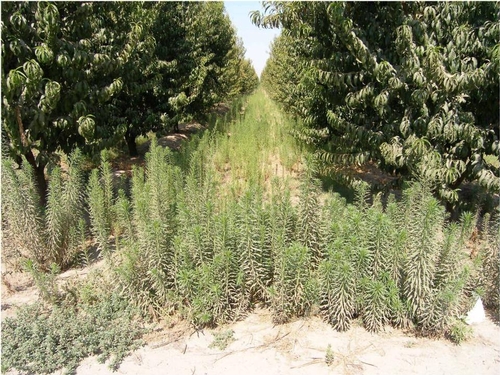*This was an article that Doug Munier and I put together and tweaked for a couple orchard crop newsletters in summer/fall 2010. I thought I'd repost it here for posterity... Brad
Controlling Glyphosate-Resistant Weeds in Orchards with Rely:
Understanding the Issue and Managing the Solutions
Brad Hanson, UC Weed Extension Specialist, Davis
Doug Munier, UC Farm Advisor, Glenn, Butte, and Tehama Counties
By now, many tree fruit and nut producers in the Central Valley are familiar with glyphosate-resistant weed species. In the north Sacramento Valley, glyphosate resistant ryegrass is widespread. In the south Sacramento Valley and through much of the San Joaquin Valley, many horseweed and hairy fleabane populations are no longer controlled with formerly effective glyphosate applications

For most conventional fruit and nut producers, rotating herbicide modes of action is a critical first step in reducing problems with herbicide resistant weeds while ensuring the viability of currently available herbicides. However, wherever feasible, non-chemical weed control techniques like mowing, tillage, and handweeding should also be used to supplement chemical weed control tactics.
One postemergence herbicide that is becoming more important in tree fruit and nut crops is glufosinate, commonly sold in California as Rely, Rely 200, or the newest formulation Rely 280. Rely is a very good, broad spectrum herbicide that can provide control of many common weeds, including several glyphosate-resistant species. However, similar-sounding chemical names and Rely marketing strategies have led to some confusion about the relative strengths of glyphosate and glufosinate.
The biggest difference in weed control efficacy of these two herbicides is related to the translocation, or systemic movement, of the active ingredient once it enters the plant. Glyphosate is generally very well translocated in susceptible plants while glufosinate translocation is much more limited. Because of the reduced levels of translocation, good coverage (adequate water volume, nozzle and pressure selection) is much more critical for glufosinate compared to glyphosate.
On small broadleaf weeds, glufosinate and glyphosate often provide very similar levels of control as long as spray coverage is adequate. Because the growing point of grass weeds is below the soil surface, these weeds can be more difficult to fully control with glufosinate; good burn down of treated tissue is usually observed, but regrowth can occur. Similarly, in established perennial weeds, glufosinate is usually less effective than glyphosate due to regrowth after the initial burn down.
Although Rely does not have the same weed control properties as glyphosate, especially for grasses and perennial weeds, it is a very useful herbicide for reducing selection pressure for new glyphosate-resistant weed biotypes and for managing existing glyphosate-resistant populations. Glufosinate and glyphosate have completely different target enzymes in different biosynthetic pathways. Thus far, there are very few reports of resistance to glufosinate and no reports of glyphosate-resistant weeds also being resistant to glufosinate.
|
Thumbnail comparison of glyphosate and glufosinate herbicides. |
||
|
Chemical name |
Glyphosate |
Glufosinate |
|
Trade name(s) |
Roundup, Durango, Honcho, etc |
Rely, Rely 200, Rely 280 |
|
Mode of action |
Inhibits EPSP synthase (EPSPS) enzyme |
Inhibits glutamine synthetase enzyme |
|
Selectivity |
Non-selective |
Non-selective |
|
Soil activity |
Essentially none |
Essentially none |
|
Translocation |
Very good |
Limited |
|
Coverage needed |
Less critical |
Critical – especially on larger weeds |
|
Broadleaf weed control |
Broad spectrum. Good control of small to medium plants but can vary with large weeds. |
Broad spectrum. Good control of small weeds, less effective on large weeds or dense stands due to coverage. |
|
Grass weed control |
Broad spectrum. Usually good control of vigorously growing grasses. |
Broad spectrum. Control can vary by size - seedling grasses often controlled, small established grasses may be burned down but regrow, some success with medium-sized grasses nearing maturity |
|
Perennial weed control |
Good – can vary depending on plant size and time of year |
Poor – burns tops; however plants often regrow from roots/rhizomes |
|
Resistance reported |
Yes, in California – ryegrass, horseweed, hairy fleabane, others suspected. 19 species worldwide. |
Not in California. |
When properly used as part of a well-planned weed management program, Rely can be an effective weed control and resistance management tool for walnut orchards. In particular, it is important to remember that Rely does not translocate as well as glyphosate and applications should be planned accordingly. Best season-long weed control and reduced selection of herbicide-resistant weed biotypes is likely to be obtained using combinations of preemergence herbicides, postemergence applications of glyphosate and glufosinate or other burndown materials, and non-chemical control tactics wherever possible.